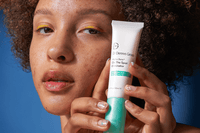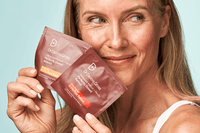Take the LED: An Introduction to LEDs & LED Skincare
13 min

Light-Emitting Diodes (or LEDs) are all around us. They’re in car headlights, traffic signals, camera flashes, greenhouse grow lamps, and medical devices. (More on the latter two in a minute.) You probably never would have guessed this, but an LED is actually a semiconductor(!) that produces light when an electric current runs through it. Compare that with old-timey filaments (in your typical bulb) or gas (used for fluorescents). Those traditional light sources now seem utterly low-tech, right?
It’s a notable distinction because inside that semiconductor material are energy bands holding electrons and electron holes. The spacing of those bands is directly correlated to the energy of the light particles (“photons” in science-speak) emitted by the LED device, determining their wavelength and color.
The basic bulb in your desk lamp? All it produces (aside from light, of course) is heat. Even if you throw a crimson scarf over it, you’re still only getting warmth and a red-tinged room (plus, a possibly burnt scarf)—not a skin treatment.
History of LED
The first LED to emit visible (as opposed to infrared) light was created in 1962 by Nick Holonyak, Jr., then a scientist working at General Electric. He was actually trying to make a semiconductor laser, which didn’t exist at the time. This is important to note because it underscores a key mistake people make: An LED is not a laser. An extremely simplified explanation is that a laser emits light in one single wavelength, while an LED produces light of multiple wavelengths. (Yes, even though the LED output may appear to be a solid color, such as red.) Also, due to their power, even non-ablative lasers can leave skin red and inflamed post-treatment. On the other hand, the energy output of LEDs is so low, you don’t need to worry about side effects, adverse reactions, or downtime. They’re simply not an issue.
LEDs might never have transitioned from your Christmas lights to your wrinkle-reduction device were it not for the National Aeronautics and Space Administration (aka NASA). In 1993, NASA began to explore the idea of using a very narrow spectrum of all available red LED wavelengths to stimulate plant photosynthesis in space. (Spoiler alert: It worked.) But their studies had an interesting side effect—the red LEDs appeared to heal the scientists’ skin lesions as well.
To understand why, a brief molecular biology lesson: Certain molecules contain chromophores, which are what give the molecule its color. Chromophores are also the reason a molecule can change when it’s exposed to light. Just like Real Housewives franchises, there are a multitude of chromophores, some of which are present in skin cells. When a specific wavelength of light hits a specific chromophore, a reaction occurs, not unlike when a targeted topical ingredient is absorbed into the skin. Change the wavelength, and you stimulate a different chromophore and get another outcome.
Fast forward to 2003, and a handheld red LED unit made for the military and developed through a civilian/NASA partnership received U.S. Food and Drug Administration (FDA) clearance. (Note: Unlike drugs, which get FDA approval, devices can only be FDA cleared.) Since then, the market has expanded exponentially with a range of at-home LED systems emitting a variety of colors and targeting a multitude of issues, from acne to arthritis.
Types of LED Lights Available

If you’re in the market for a light-based, skin-centric solution, here’s what you need to know about the many types of LED lights and their benefits:
Infrared (IR) LEDs
Wavelength: 800-1200 nanometers
Where they go: Five to 10 millimeters into skin, reaching the reticular dermis—basically the large swath of tissue you think of when someone says “dermis.”
What they do: Rev up circulation and encourage wound healing.
Who they’re for: People who want to prevent collagen breakdown. There’s a dearth of published research on the effectiveness of IR LEDs by themselves. Instead, they’re often used in tandem with a visible light therapy.
Red LEDs

Wavelength: 630-700 nanometers
Where they go: Two to three millimeters deep, hitting the very top of the dermis (known as the papillary dermis), home to the papillary fibroblasts.
What they do: Stimulate those fibroblasts, leading to increased collagen production, and lower the skin’s amount of MMP-1, which is the enzyme that breaks down the healthy collagen you’re trying so hard to hang onto. Plus, they reduce inflammation.
Who they’re for: Anyone who wants to reduce the appearance of fine lines, wrinkles, or hyperpigmentation. A red LED treatment is often recommended right after an in-office peel or laser treatment, due to its ability to bring down redness immediately. Other skin improvements usually become visible after four weeks of consistent red LED use.
Yellow LEDs

Wavelength: 570-590 nanometers
Where they go: Anywhere from 0.5 to two millimeters deep, which correlates to the dermal-epidermal junction and the papillary dermis.
What they do: Up the manufacture of ATP, the molecule that’s akin to a battery for cells, as well as accelerate fibroblast activity.
Who they’re for: Those for whom photoaging is a concern, with one caveat: Results from peer-reviewed clinical research of yellow LEDs used on skin have been mixed. Some have shown improvements, while others have been unable to replicate the outcomes of previous studies. For that reason, you may want to hedge your bets and avoid using yellow LEDs alone. Instead, try them in combination with another LED color, such as red, for example, if your focus is photoaging.
Blue LEDs

Wavelength: 400-470 nanometers
Where they go: Less than one millimeter into skin, meaning they only impact the epidermis.
What they do: In a nutshell, blue LEDs cause P. acnes bacteria to implode. Since P. acnes bacteria are often a contributing factor to one’s breakout, this leads to a faster return to blemish-free skin. Unlike topical acne treatments, which can sometimes dry out skin as they clear it, blue LEDs only impact P. acnes bacteria, leaving everything else untouched.
Who they’re for: Acne sufferers, whether it’s the occasional blemish or more persistent outbreaks.
But wait, I thought blue light was bad?
There’s been a lot of buzz around the blue light emitted from our electronic devices and fears that we may be aging ourselves with every Zoom meeting. It’s only reasonable to wonder if using blue LEDs to diminish acne is a case of robbing Peter to pay Paul (i.e. that in lowering your incidence of breakouts you may actually be increasing your incidence of wrinkles). But fear not! There are many wavelengths of blue light, and not all of them destroy collagen. The wavelength used in blue LEDs for acne is specifically calibrated to target only the corresponding chromophore in skin—nothing else. Whew.
What about doubling up on LEDs?
Excellent idea! Just like two heads are better than one, so are two LED wavelengths. A number of published clinical studies have shown that combining LED wavelengths (such as red and IR or red and blue) can have a synergistic effect on skin that’s more impactful than a solo wavelength—especially in regard to minimizing photoaging or acne.
At-home versus in-office: Which type of LEDs are better?
As previously noted, a dermatologist might recommend you stay for an LED session right after your peel or laser treatment to keep resulting redness at bay. But you can also go to a doctor’s office for an LED dose by itself.
However, like sunscreen, LEDs need to be used daily to achieve the desired results. If you’re only visiting your derm’s office once a month for an LED session, you’re most likely not going to see the improvements in lines and wrinkles that you’re hoping for. And you’re going to spend a lot of money for that first-hand knowledge.
Depending on where you live, a single in-office LED treatment can range from $25 to $85 and up. A DIY device may seem like a more significant cash outlay upfront (fair, considering some can cost as much as $495 or more), but amortize that expense over daily use, and an at-home device becomes a practical investment and less expensive than the in-office alternative.
So how do I get the most out of my at-home device?
Firstly, read and follow the instructions that come with your equipment (duh). But there are a few other ways to ensure you get maximum impact:
1) Verify that your device is FDA cleared.
This will confirm that the promises made on the package concerning the wavelengths of the LEDs inside are accurate and have been corroborated. The FDA keeps an online database of devices it’s cleared, if you want to do your own research, but the manufacturing company itself won’t keep this information secret. Getting FDA clearance is no cakewalk, so brands don’t typically hide that they’ve received this designation.
2) Look for a tool that sits flush to your skin.
The less distance the light particles need to travel to reach their target, the greater their penetration once they arrive.
3) FYI: It won’t work sitting in your closet.
LEDs are not a one-and-done. You need to use your apparatus for the time and frequency prescribed. (Generally, a few minutes a day, every day.) On the bright side, you can do an LED treatment morning or night, whenever the mood strikes you—there’s no risk of sun sensitivity.
4) Use your device on clean, dry skin.
You don’t want anything to impede light from connecting with chromophores, so save the serums and sunscreen for after your LED sesh.
5) Speaking of sunscreen, you still need it.
As well as the rest of your topical skin care program, for that matter. LED therapy isn’t a replacement for your current regimen; it’s an adjunct.
Explore Our Range Of LED Devices
Discover Dr. Dennis Gross LED Skincare
For more skincare tips and insight on the world of LED from the experts at Dr. Dennis Gross, check out our blog’s newest content. Shop the collection of Dr. Dennis Gross bestselling skincare backed by dermatologists and our line of at-home skincare devices.
Original article published on September 27th, 2021. Updated on September 21st, 2022.

Written By
Ben Gentzler
Ben Gentzler has worked in the beauty industry for 17 years — 10 of which were spent in clinical skincare. He is a licensed esthetician with a passion for leading professional education on cutting edge treatments at top spas around the world and for training on the science of skin. Ben has trained directly with Dr. Dennis Gross, learning about the state of the art in skincare and working with his clients to help them achieve their best skin.
Read More from Ben Gentzler
Written By
Ben Gentzler
Ben Gentzler has worked in the beauty industry for 17 years — 10 of which were spent in clinical skincare. He is a licensed esthetician with a passion for leading professional education on cutting edge treatments at top spas around the world and for training on the science of skin. Ben has trained directly with Dr. Dennis Gross, learning about the state of the art in skincare and working with his clients to help them achieve their best skin.
Read More from Ben GentzlerRelated Articles
-

acne, author-ben-gentzler, skin-and-deeper April 03, 2024 — 6 minutes
Hit It: Introducing The Dr. Dennis Gross Alpha Beta On The Spot Eliminator
by Ben Gentzler
-

author-ben-gentzler, myth-busting, oily-skin, skin-and-deeper April 01, 2024 — 9 minutes
Myth busted: Yes, your oily skin does need a moisturizer
by Ben Gentzler
-

author-ben-gentzler, pro-tips, retinol, skin-and-deeper March 25, 2024 — 5 minutes
How to Use Perfectly Dosed Retinol Pads Like a Pro
by Ben Gentzler
Keep Reading
Stay up to date on the latest advice from our team of skincare experts.
Sign up to receive a monthly digest of skincare, wellness, and lifestyle tips.







